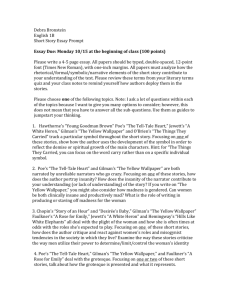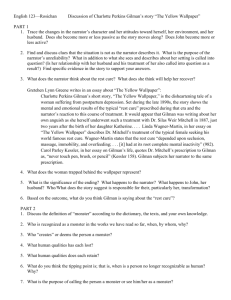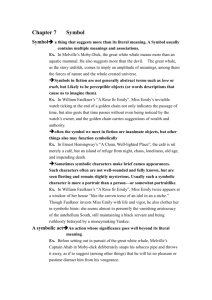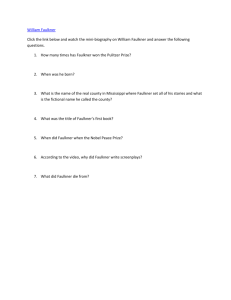A Rose for Emily and the Yellow Wallpaper: A Comparative Study
advertisement
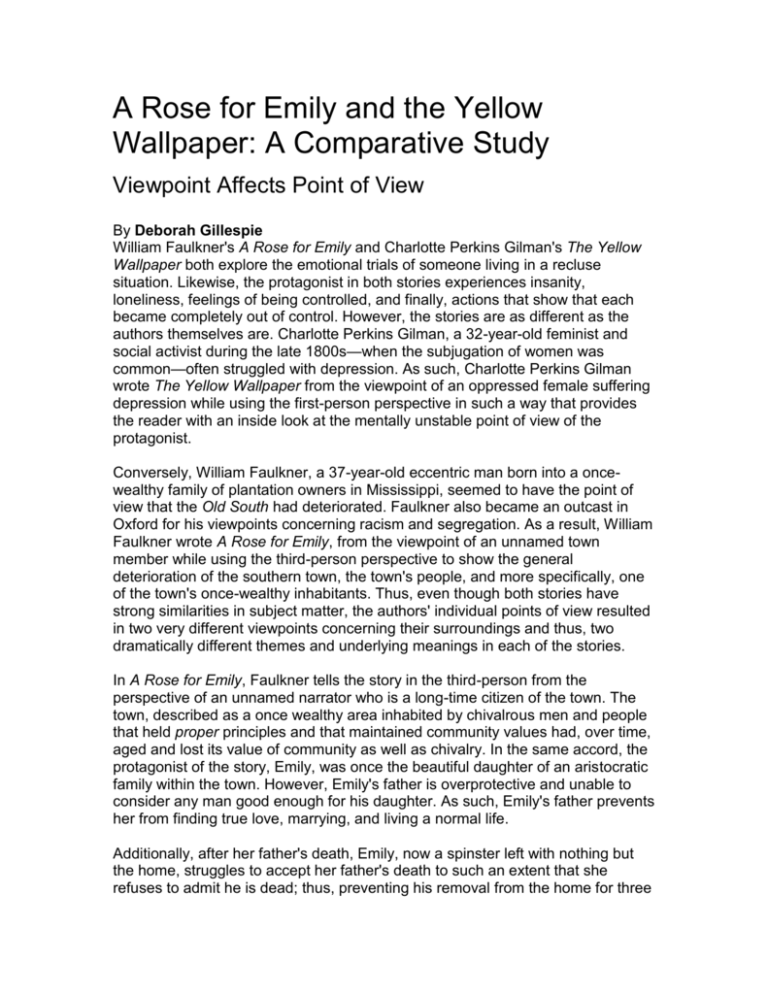
A Rose for Emily and the Yellow Wallpaper: A Comparative Study Viewpoint Affects Point of View By Deborah Gillespie William Faulkner's A Rose for Emily and Charlotte Perkins Gilman's The Yellow Wallpaper both explore the emotional trials of someone living in a recluse situation. Likewise, the protagonist in both stories experiences insanity, loneliness, feelings of being controlled, and finally, actions that show that each became completely out of control. However, the stories are as different as the authors themselves are. Charlotte Perkins Gilman, a 32-year-old feminist and social activist during the late 1800s—when the subjugation of women was common—often struggled with depression. As such, Charlotte Perkins Gilman wrote The Yellow Wallpaper from the viewpoint of an oppressed female suffering depression while using the first-person perspective in such a way that provides the reader with an inside look at the mentally unstable point of view of the protagonist. Conversely, William Faulkner, a 37-year-old eccentric man born into a oncewealthy family of plantation owners in Mississippi, seemed to have the point of view that the Old South had deteriorated. Faulkner also became an outcast in Oxford for his viewpoints concerning racism and segregation. As a result, William Faulkner wrote A Rose for Emily, from the viewpoint of an unnamed town member while using the third-person perspective to show the general deterioration of the southern town, the town's people, and more specifically, one of the town's once-wealthy inhabitants. Thus, even though both stories have strong similarities in subject matter, the authors' individual points of view resulted in two very different viewpoints concerning their surroundings and thus, two dramatically different themes and underlying meanings in each of the stories. In A Rose for Emily, Faulkner tells the story in the third-person from the perspective of an unnamed narrator who is a long-time citizen of the town. The town, described as a once wealthy area inhabited by chivalrous men and people that held proper principles and that maintained community values had, over time, aged and lost its value of community as well as chivalry. In the same accord, the protagonist of the story, Emily, was once the beautiful daughter of an aristocratic family within the town. However, Emily's father is overprotective and unable to consider any man good enough for his daughter. As such, Emily's father prevents her from finding true love, marrying, and living a normal life. Additionally, after her father's death, Emily, now a spinster left with nothing but the home, struggles to accept her father's death to such an extent that she refuses to admit he is dead; thus, preventing his removal from the home for three days. Later, the now reclusive Emily meets Homer Barron, a man holding a temporary contract to work in the town. Town members notice the time Emily and Homer spend together and assume they will marry. However, as time passes, no one sees Homer again but everyone with interest in the situation appears content in assuming that he must be living a reclusive life with Emily in the home. However, upon Emily's death, town members enter her home and discover the corpse of Homer in an upstairs bedroom lying on the bed next to a pillow with a strand of Emily's hair on it leaving the reader to assume that Emily murdered Homer in an effort to keep him and his imaginary love with her for all-time. To gain a deeper understanding of the underlying meaning found in A Rose for Emily, one must also attempt to gain a deeper understanding of the points of view and ultimate viewpoint of the story's author. As noted earlier, William Faulkner belonged to a once-wealthy family of plantation owners in Oxford Mississippi. According to Kathleen Wilson (1997), Faulkner also grew up enjoying the myths and stories of the area and he especially enjoyed stories about his great-grandfather and namesake William Clark Falkner also known as the Old Colonel (p. 248). Interestingly, Faulkner, who often uses his own life experiences and family members as inspirations in his stories, uses his grandfather as the inspiration for the character Colonel Sartoris in A Rose for Emily. Even more fascinating, Faulkner appears to use himself as the inspiration for Emily, the main character in the story. The similarities include the fact that both Emily and Faulkner are eccentric, grow up in the south, witness the deterioration of their surroundings, and attempt to change reality to suit their personal desires and satisfy their need to make things how they believe they should be rather than how they are. For example, according to Wilson (1997), "Faulkner added the u to the spelling of his name when he joined the Royal Canadian Air Force so that it would appear more British. Faulkner also explained his limp and use of a cane as being a result of war wounds and told stories about his experiences as a pilot during a war he never fought. Furthermore, just as Emily witnessed the deterioration of her southern environment, so did Faulkner. Thus, when Faulkner wrote "A Rose for Emily" at age 37, he wrote the story from a third person perspective of someone seeing the steady breakdown of an aging and changing society both inside and out. E.g. as the old south that Faulkner resided in had lost its prestige and beauty, undoubtedly affecting him personally, so did age and decay affect the town and main character in A Rose for Emily. Conversely, in The Yellow Wallpaper, Charlotte Perkins Gilman tells the story in the first-person from the perspective of the unnamed protagonist herself. In this story, a women suffers from what appears to be post-partum depression and her husband, a medical doctor, chooses to enforce the rest-cure, a treatment that insists the patient should avoid all forms of mental and physical stimulation in favor of total and complete rest until healthy once again. As a result, the mentally unstable women, her husband, their child, and the husband's sister, move into a temporary residence as a means of enforcing the treatment. Once in the home, the husband locks his wife, the unnamed protagonist, in a room once used as a nursery on the top floor of the home. The unnamed protagonist describes the room as cell-like with bars on the window and a bed bolted to the floor with ugly and deteriorating yellow wallpaper containing indefinable patterns on the walls. While there, John, the woman's husband, prevents her from seeing her child or writing. However, the woman finds a way to keep a diary and excerpts from these writings provide the means for sharing this woman's thoughts with the reader. As such, the diary excerpts not only show how the woman's mental stability continues to fail but also how much the yellow wallpaper she stares at daily affects her. She begins to notice patterns in the wallpaper that resemble bars and eventually a woman trapped behind the bars trying to escape. According to Siegel (2008), "the narrator's emotions, right from the beginning, seem close to the surface and yet muted somehow by a sense that the narrator cannot or will not see her impending madness" (p. 2). The diary excerpts also reveal to the reader the woman's desire to remove all the wallpaper from the walls not only to free the imagined trapped women but also to prevent the wallpaper from trapping the unnamed protagonist as well. At the end of the story, only two days before her and her family are to leave the home, and after determining that suicide would be "improper and might be misconstrued" her mental stability is completely lost and she begins circling the room compulsively essentially becoming the trapped woman behind the bars of the wallpaper. As with Faulkner's story, to gain a deeper understanding of the underlying meaning found in Gilman's The Yellow Wallpaper, one must also attempt to gain a deeper understanding of the points of view and ultimate viewpoint of Charlotte Perkins Gilman. Charlotte Perkins Gilman's single and struggling mother raised Gilman and her sibling in the north. According to Abcarian & Klotz (2007,) Gilman's "mother was unable to provide her children with a secure and stable childhood" (p. 1157). Additionally, after the birth of Gilman's only child, "Gilman was immobilized by a deep depression" (Abcarian & Klotz, p. 1157). To make matters worse, a respected and noted neurologist, S. Weir Mitchell, prescribed Gilman the "rest-cure"—a treatment that requires the patient to avoid all forms of mental and physical stimulation—and like the unnamed protagonist in the story, Gilman believed her husband at the time forced the treatment to an unhealthy extent. After a while, Gilman decided that the treatment was not only unbearable but also served to keep her insane instead of helping her to become well again. As a result, Gilman abandoned the treatment and her husband in hopes of living a well-rounded, sane, and successful life. Thus, when Gilman wrote The Yellow Wallpaper at age 32, she wrote a story about a woman with a single child that felt caged in a room by a husband that was sustaining her insanity by also enforcing the "rest-cure" to an unhealthy extent. Furthermore, Gilman's story depicts the desire and ultimate perceived success of the women's ability to break free from the cage. Due to the intimate relationship between Gilman's life and the story, Gilman was able to write the story from a first person perspective in such a way that portrayed the true plight of the individual personally and with careful consideration for the character's emotions and resulting actions. After reading each of the stories and researching the biographies of their respective authors, one can understand better the characterization, setting, symbolism, and realism within both stories. For example, Faulkner uses himself and others surrounding him as an inspiration for his characters in such a way that enables him to describe them in more detail and include intimate knowledge of their activities. Additionally, Gilman establishes setting in such a way that includes symbolism by having the unnamed protagonist describe her surroundings as a rather nice home—almost a mansion—with gardens. However, the unmaintained structure, barred window, bolted down bed and ugly wallpaper seem to symbolize the true feelings and mental condition of the narrator—a woman caged, controlled, and unstable in otherwise fine surroundings. Moreover, both authors make extensive use of symbolism throughout the story. According to Wilson (1997), the yellow wallpaper in Gilman's story not only symbolizes the protagonist's state of mind, but also "in a more general sense, the wallpaper symbolizes the way women were viewed in nineteenth-century society" e.g. "containing pointless patterns, lame uncertain curves, and outrageous angles that destroy themselves in a heard of contradictions" (p. 282). Additionally, the nursery itself may symbolize society's view of women as children in the early nineteenth-century while the bars may represent the "emotional, social, and intellectual prisons in which women of that era were kept" (p. 282). Likewise, Emily's house in Faulkner's story seems to symbolize the old south itself as it "had once been white, decorated with cupolas and spires and scrolled balconies" but has since become "an eyesore among eyesores" (1.2). Nevertheless, even though both authors used a great deal of symbolism, realism also shines through with the literal descriptions of how things were during the stories' respective time eras. For example, the woman in Gilman's story was financially dependent on her husband, not permitted to make her own decisions, and frequently treated as a child. Likewise, the southern town and town's people in Faulkner's story behaved normally for people of that time era and their treatment of one another changed as time passed just as it did in documented history. Therefore, it is the well thought out marriage of symbolism and realism coupled with superb descriptions to assist with setting and characterization that make both of these stories powerful as merely enjoyable works of fiction as well as meaningful pieces of literature one should keep in his or her literary canon. In summation, both Faulkner and Gilman used personal life experience to write stories depicting their views of what happened around them with the use of outstanding writing skills to include excellent characterization and symbolism within detailed settings. However, Faulkner's story, though created with characters inspired from his own life, came from his outside point of view of society as a whole while Gilman's story was from a more personal and intimate viewpoint. Ironically, in both cases the stories depicted the emotional trials of an adult female living a reclusive lifestyle and falling deeper and deeper into insanity as time passed. However, Faulkner's story depicted an aging town with an eccentric main character being controlled by her father and losing control of herself from a third person perspective while Gilman's story depicted a main character being controlled by her spouse and losing control of herself from the first person perspective. As a result, one can assume Gilman's personal experience encouraged her to provide readers with a more personal perspective of what the main character was going through while Faulkner's experience encouraged him to provide readers with his general view of society's decay. Thus, each author's point of view affected his or her viewpoint; and this played an incredible role in causing two stories with similar plots to encompass two very different themes and underlying meanings. References Abcarian, R., & Klotz, M. (2007). Literature: The human experience (9th ed.). Boston, MA: Beford/St. Martin's. Siegel, J. S. (2008). Charlotte Perkins Gilman. Retrieved September 22, 2009, from http://www.charlotteperkinsgilman.com/2008/04/i-introduction.html Wilson, K. (1997). A Rose for Emily: Short stories for students (1 ed.). Detroit, MI: Gale. Wilson, K. (1997). The Yellow Wallpaper: Short stories for students (1 ed.). Detroit, MI: Gale.

